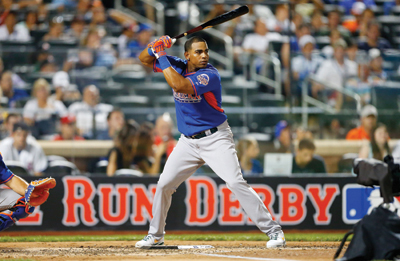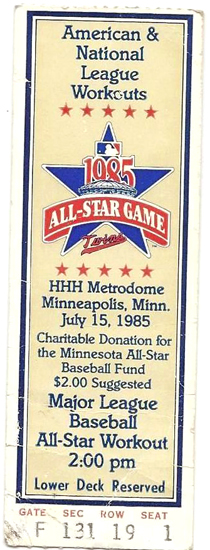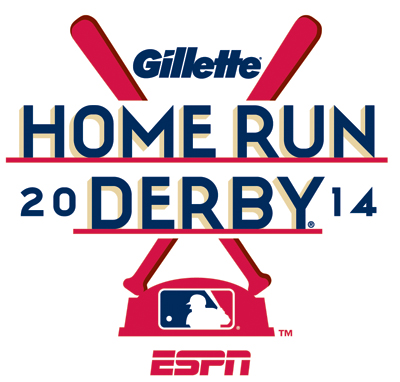This year, MLB’s annual Home Run Derby at the All-Star Game returns to Minnesota, where it began in 1985. In the nearly 30 years since its debut, memories of the Derby’s origins have become a bit clouded.
The Home Run Derby is certainly a legacy of former MLB Commissioner Peter Ueberroth, who wanted to revive all of baseball’s jewel events when he took office in 1984.
“We’d had spotty attendance, so we wanted to do something to give [the day before the All-Star Game] Workout Day some flair,” said Laurel Prieb, MLB’s vice president of Western operations, then working as the All-Star Game coordinator for the Twins. “This was a new administration that wanted to mix things up for Peter’s first jewel event.”
Former MLB Properties President Rick White, then running special events for the league, recalled that during a staff meeting late in 1984, Ueberroth asked for ideas that would bring a renaissance to MLB’s All-Star Game.
Remembering the black-and-white “Home Run Derby” TV series from 1960 and similar contests staged locally by MLB teams, White suggested an All-Star equivalent.
“Pete said, ‘Great — you get to go do it,’” White chuckled.
Then, as now, the two biggest problems were finding a Home Run Derby format acceptable to competitors and fans, and persuading the game’s best to compete.
The Home Run Derby rules this year were tweaked to increase the field from eight to 10 sluggers, and to reduce the
 |
Yoenis Cespedes swings his way to the title at last year’s Home Run Derby at New York’s Citi Field.
Photo by: Getty Images |
number of outs per at-bat. Indeed, the format has changed often over the years.
From 1985-90, the competition was two “innings” with participants getting five outs per inning. In 1991, eight to 10 players were chosen to participate in a three-round contest, with 10 outs per round. The contest has changed from a National League vs. American League affair for its first 11 years, to a player vs. player contest. At least one Home Run Derby featured players competing on behalf of their native countries. In 2011, team “captains” began selecting the participants.
Attracting the top home run hitters to the Derby has not been easy. Some players feel it harms their hitting approach well beyond the All-Star Game. As a result, Oakland’s Yoenis Cespedes last year became the first player to win the Home Run Derby without being selected to the All-Star Game.
White recalled that in the Home Run Derby’s initial year, he used the power of an NBA all-star event to attract top MLB talent.
 |
Tickets to the 1985 Workout Day bore no mention of the first Derby.
|
“We only had one thing going for us,” said White. “The NBA slam dunk contest was huge then and it had Dr. J, Dominique Wilkins and all their best competing — that was the hook we used to get our players to compete.”
Apparently that pitch worked. The first Home Run Derby included five eventual hall of famers.
“As soon as I saw we’d filled up the place that first year, I knew we had a hit,” said Prieb. “Then it was the hometown boy [Tom] Brunansky against Dave Parker in the finals — that was great theater.”
However, no one outside the Hubert H. Humphrey Metrodome saw that contest. In the 1980s, the Home Run Derby wasn’t televised. ESPN has broadcast the event since 1993, but it was not a live telecast until 1998.
Gatorade, which still sponsors the overall Workout Day, appears to also have been the first Home Run Derby sponsor from 1991 through 1995. Gillette sponsors this year’s contest and it also sponsored in 1996 and 1997.
Service Merchandise sponsored in 1998; Century 21 from 1999-2007; State Farm from 2008-12; and Chevrolet in 2013.
Longtime Gatorade sports marketing chief Bill Schmidt recalled that when he joined Gatorade after working for the 1984 Olympics, the beverage marketer was already sponsoring its own Home Run Derby, with MLB players competing locally, culminating in a championship at the World Series.
“The problem was, we did it at 9 in the morning, in an empty stadium,” Schmidt said. “When MLB came up with its own version, we jumped on it. The fact that I had worked with Ueberroth made that a relatively easy negotiation. It’s what made the Workout Day a sellout every year.”
Curiously, tickets for the first Home Run Derby, then as now, paired with the All-Star Game Workout Day, bore no mention of the slugging contest (see photo). Admission was a $2 “suggested donation” for charity. Any kid who showed up carrying a baseball glove got in free.
Tickets for this year’s Workout Day and Home Run Derby in Minnesota were sold only as a package with other All-Star Game events; their face value ranges from $100 to $350. Of course, money raised for charity through the event has also grown exponentially (see story).
Another interesting sidelight from the first Home Run Derby: Ueberroth insisted on having Little Leaguers in the outfield shagging flies, despite the objections of some MLB officials, who were fearful of possible injuries and liability.
“Everybody loves the long ball,” said Schmidt, adding that he still has one of the Home Run Derby trophies. “I look forward to the Home Run Derby more than the All-Star Game. It’s one of the few times you can see professional athletes still acting like kids playing a game.”






